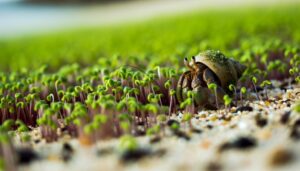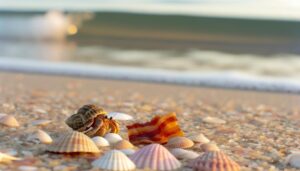Perfect 10-Gallon Hermit Crab Tank Setup: Tips and Inspiration
Creating a thriving 10-gallon hermit crab tank involves selecting the right substrate blend, such as play sand and coconut fiber, with a depth of at least 6 inches. Maintain tank temperature between 75°F and 85°F using a digital thermometer and an under-tank heater.
Keep humidity levels at 70%-80% with daily misting and a hygrometer. Provide both fresh and saltwater in shallow containers, ensuring they’re dechlorinated and changed regularly.
Enhance the tank with climbing structures like Cholla Wood and cork bark, and offer a variety of fresh fruits, vegetables, and protein sources for balanced nutrition. Continue exploring for detailed guidance on enrichment and maintenance.

Key Takeaways
- Use a blend of play sand and coconut fiber as substrate, maintaining a depth of at least 6 inches.
- Ensure tank temperature stays between 75°F and 85°F, using a digital thermometer placed at substrate level.
- Maintain humidity levels between 70% and 80% with daily misting and partial tank cover.
- Provide both freshwater and saltwater in shallow, sturdy containers, changing them regularly.
- Include climbing structures like Cholla Wood and Cork Bark to promote exercise and mental well-being.
Choosing the Right Substrate
Selecting the right substrate for your hermit crab tank is crucial as it directly influences their ability to molt, burrow, and maintain proper humidity levels. You’ll want to choose a substrate that mimics their natural habitat.
A blend of play sand and coconut fiber (like Eco Earth) offers ideal consistency and moisture retention. Aim for a depth of at least 6 inches to allow proper burrowing. Avoid calcium sand, as it can harden and cause impaction.
Regularly monitor and maintain substrate moisture by lightly misting it, ensuring it’s damp but not waterlogged. This balance aids in creating a stable, humidity-rich environment necessary for your hermit crabs’ wellbeing.
Optimal Tank Temperature
Maintaining the best tank temperature is just as important as selecting the right substrate, as it directly affects your hermit crabs’ metabolism, activity levels, and overall health. Aim to keep the tank temperature between 75°F and 85°F. Use a reliable digital thermometer to monitor this range accurately. Position the thermometer on the substrate level to guarantee accuracy.
If the temperature drops below 70°F, your hermit crabs risk becoming lethargic and susceptible to illnesses. Conversely, temperatures above 85°F can cause stress and dehydration. Consider using an under-tank heater (UTH) specifically designed for hermit crabs, placed on one side of the tank to create a gradient. This allows your crabs to self-regulate by moving to their preferred temperature zone.
Maintaining Proper Humidity
To secure your hermit crabs thrive, it’s important to maintain the tank humidity level between 70% and 80% using a hygrometer for precise monitoring. Proper humidity secures their gills function effectively and prevents dehydration.
Here’s how you can achieve this:
- Use a hygrometer: Place it inside the tank at crab level for accurate readings.
- Mist the tank daily: Use dechlorinated water to increase humidity without harmful chemicals.
- Substrate choice: Opt for a mix of sand and coconut fiber; it retains moisture well.
- Cover the tank: A partially covered lid helps trap humidity, balancing airflow and moisture.
Essential Water Sources
For your hermit crabs’ well-being, it’s vital to provide both fresh and saltwater sources, making sure they’ve access to the necessary minerals and hydration.
Freshwater should be dechlorinated using an appropriate water conditioner to eliminate harmful chemicals.
Saltwater, on the other hand, must replicate their natural habitat; use marine salt mix, not table salt, to achieve the correct salinity.
Offer these water sources in shallow, sturdy containers to prevent spills and ensure easy access.
It’s also important to regularly monitor and change the water to maintain cleanliness and prevent bacterial growth.
Safe Climbing Structures
Incorporating safe climbing structures into your hermit crab tank encourages natural behaviors and provides essential exercise, promoting both physical and mental well-being.
To guarantee your hermit crabs thrive, consider the following structures:
- Cholla Wood: This porous, lightweight wood is perfect for climbing and doesn’t splinter easily, making it a safe option.
- Cork Bark: Naturally mold-resistant and easy to manipulate, cork bark offers a varied texture for climbing.
- Plastic Mesh Ladders: These are durable and customizable, allowing you to create vertical and horizontal climbing paths.
- Rocks: Smooth, non-splintering rocks can be stacked to create a multi-level environment, ensuring safety while mimicking their natural habitat.
Each of these options provides a stimulating and secure environment, essential for your hermit crabs’ overall health.
Ideal Hiding Spots
You should consider incorporating coconut shell hideouts, as they provide durable, natural-looking shelters for your hermit crabs.
Additionally, integrating moss-filled caves can create humid microenvironments, which are essential for maintaining proper humidity levels.
These elements will offer your hermit crabs both comfort and security, enhancing their overall habitat.
Coconut Shell Hideouts
Coconut shell hideaways, with their natural texture and durability, provide hermit crabs with an ideal and secure hiding spot, replicating the protective environments they seek in the wild.
To create these hideaways, follow these steps:
- Select Quality Shells: Choose sturdy, uncracked coconut shells to guarantee longevity and safety.
- Prepare the Shell: Thoroughly clean and dry the shell to remove any residual coconut meat or bacteria.
- Create Entry Points: Cut smooth, appropriately-sized openings to allow easy access for your hermit crabs.
- Placement in Tank: Strategically place the shells in low-traffic areas of the tank to minimize stress and optimize comfort.
Moss-Filled Caves
Moss-filled caves, crafted from natural materials, offer hermit crabs an ideal microhabitat that maintains humidity levels while providing essential cover and comfort.
When creating these caves, use non-toxic adhesives and untreated wood for the structure. Select sphagnum or sheet moss to line the interior, ensuring it retains moisture effectively.
This setup not only mimics the hermit crabs’ natural environment but also promotes healthy molting cycles by maintaining the necessary humid conditions. Place these caves in shaded tank areas to prevent excessive drying and to create secluded spots where your crabs can retreat.
Regularly mist the moss to keep it damp and replace it as needed to prevent mold growth, ensuring a safe and thriving habitat for your hermit crabs.
Suitable Tank Plants
When selecting suitable tank plants for your hermit crabs, consider species that thrive in high humidity and can withstand the crabs’ natural curiosity and climbing behavior. Choose resilient, non-toxic plants to create a healthy, enriching environment for your hermits.
Here are some excellent options:
- Spider Plants: Hardy and adaptable, these plants can tolerate the high humidity and occasional nibbling.
- Pothos: Known for their durability, they thrive in low light and high humidity, perfect for hermit crab tanks.
- Bromeliads: These plants can hold water in their leaves, adding humidity and a tropical feel to the tank.
- Air Plants (Tillandsia): Require minimal soil, making them ideal for hermit crab habitats while providing climbing opportunities.
Feeding and Nutrition
When addressing your hermit crab’s feeding and nutrition needs, make sure you’re providing a balanced diet that includes proteins, fruits, vegetables, and calcium supplements.
You’ll need to identify safe food options like unseasoned meats, leafy greens, and cuttlebone to prevent toxicity.
Regularly rotating their diet helps mimic their natural foraging behavior and promotes overall health.
Balanced Diet Components
Understanding the essential components of a balanced diet for your hermit crabs is crucial to ensuring their health and longevity. A balanced diet consists of a variety of food sources that provide all necessary nutrients. You should focus on delivering the following components:
- Proteins: Essential for growth and exoskeleton maintenance. Sources include fish, shrimp, and other seafood.
- Calcium: Essential for exoskeleton strength. Provide crushed oyster shells or cuttlebone.
- Fats: Necessary for energy. Nuts and seeds are excellent choices.
- Vitamins and Minerals: Guarantee a mix of fruits and vegetables for overall health.
Safe Food Options
Selecting safe food options for hermit crabs requires careful attention to avoid harmful ingredients and guarantee nutritional balance. You should prioritize fresh fruits and vegetables, making sure they’re pesticide-free. Safe choices include apples, carrots, and spinach.
Avoid citrus and onions, as they can be harmful. Protein is vital; offer boiled eggs, unseasoned chicken, or fish. Commercial hermit crab foods can be used but check for preservatives like Ethoxyquin, which are dangerous.
Calcium is essential for shell health, so provide cuttlebone or crushed eggshells. Rotate foods to prevent dietary deficiencies. Always remove uneaten food after 24 hours to maintain tank hygiene.
Regular Cleaning Routine
Establishing a regular cleaning routine for your hermit crab tank is crucial to maintain a healthy and hygienic environment for your pets. Begin by setting a weekly schedule to guarantee thorough maintenance. Follow these steps:
- Remove Debris:
Daily, eliminate uneaten food and waste to prevent bacterial growth.
- Substrate Stirring:
Weekly, agitate the substrate to aerate and prevent mold.
- Spot Cleaning:
Regularly clean the glass and accessories with a non-toxic cleaner.
- Water Changes:
Refresh salt and freshwater dishes every other day to secure hydration and proper molting conditions.
Stimulating Toys and Enrichment
To secure your hermit crabs stay active and mentally stimulated, incorporate a variety of toys and enrichment items into their tank environment. Diverse enrichment will not only keep them physically active but also mentally engaged, reducing stress and promoting natural behaviors.
| Category | Example Toys | Benefits |
|---|---|---|
| Climbing | Branches, Cholla Wood | Enhances muscle strength |
| Hiding | Coconut Shells, Ceramic Caves | Provides security and privacy |
| Foraging | Food Puzzles, Shell Shops | Encourages natural foraging |
| Sensory | Sand Pits, Moss Beds | Stimulates tactile exploration |
Each category targets different aspects of their well-being. Make sure to rotate toys regularly to maintain their interest and adapt to their evolving preferences.
Conclusion
So there you have it. Your hermit crabs will unquestionably thrive in their 10-gallon palace, provided you’ve meticulously followed every minute detail.
After all, nothing screams “natural habitat” like a climate-controlled, artificially lit glass box with faux plants.
Remember, the goal is to replicate the wild as accurately as possible—within the confines of your living room.
Don’t forget, your hermit crabs are counting on you to make their captivity as luxurious as possible!






